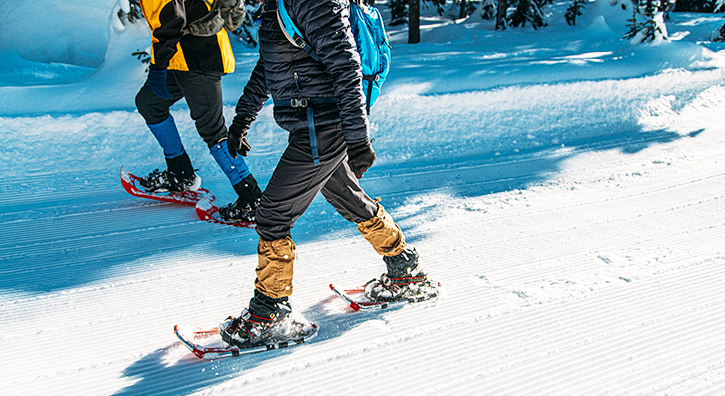0800 260 5082
Available from Monday to Friday from 9am to 7pm, and Saturday from 10am to 7pm. Closed on Sunday.
Available from Monday to Friday from 9am to 7pm, and Saturday from 10am to 7pm. Closed on Sunday.
Snowshoeing is a popular off-ski activity, loved by both skiers and non-skiers. It’s accessible to everyone – including children and those with a gentler level of fitness. This relaxing sport is a great way to discover the snowy landscape at your own pace. Follow our tips to make the most of your winter holiday.
Snowshoes are walking aids attached to your boots, designed to give you better grip on snow. They are fitted with spikes and cleats that dig into the snowy ground for stability. Snowshoeing, often enjoyed during a ski holiday, involves hiking in mountainous areas across snow-covered trails. More than just a leisure activity, snowshoeing has become a true sport – you can burn up to 1,000 calories in an hour and reach higher peaks with customised snowshoes.

Snowshoeing is a great way to unwind and reconnect with nature, often along trails deep in the forest. If you enjoy this, we highly recommend trying ice floating – a unique experience of calm and relaxation that lets you connect with the natural world around you.
One common myth about snowshoeing on a ski holiday is that it’s harder than regular hiking. In reality, the only real requirement is to be in good physical condition. However, there are a few essential points to follow to ensure your safety during the walk.
To stay safe on a snowy mountain, there are a few key points to keep in mind. Snowshoeing routes in ski resorts are usually marked out by organisers in line with safety standards. Following these marked trails is essential to avoid getting lost or entering risky areas. To prevent unpleasant surprises from snow conditions, it’s also recommended to take an avalanche awareness or snow science course before venturing out alone. With this knowledge, you’ll know how to adapt to changes in snow formation and stability. Always check the weather forecast to avoid any risk of avalanches, heavy fog, or extreme temperatures. If it’s your first outing, it’s often wiser to go with a guide.
When it comes to a mountain outing, a guide is not strictly necessary as long as you are properly equipped and follow safety instructions. However, having one is highly recommended if you are a beginner. A guide can teach you how to read maps and use a compass, as well as show you how to stick to marked trails. They can also help you adjust your breathing to the mountain air, saving energy and making your walk more comfortable.
In terms of fitness level, snowshoeing is no more demanding than regular hiking. You just need to be able to walk for one to two hours. With the right clothing and by keeping an eye on the weather, the cold won’t be a problem, as you’ll be well protected.
Best winter ski destinations

For snowshoeing equipment, the basic rule is to choose snowshoes that can be attached to different hiking boots. This way, even if you change your footwear, you can still use the same snowshoes. There are many models and brands available that adapt to various types of boots. When choosing your snowshoes, you should consider your weight for easier handling, the type of slopes you’ll tackle for the shape of the cleats and spikes, and your boots for a proper fit. As for poles, a good pair of trekking poles will do the job perfectly.
When it comes to clothing, staying warm is key, from hats to boots, as well as tops and trousers. Choose a thick hat that will keep you fully warm and cover your ears completely. Protect your upper body with a waterproof jacket. For trousers, opt for multi-layered hiking or ski pants that are flexible. Some trousers have side zips to help release excess heat. Gloves and socks should also be warm and waterproof. Your goggles should provide side coverage and protect against glare. Finally, don’t forget a good lip balm and sunscreen to protect your face.

There are many places to enjoy snowshoeing on a ski holiday. In the Alps, you can try it at resorts such as Aillons-Margeriaz, Alpe d’Huez, Albiez-Montrond, Autrans, Abriès en Queyras, Auron, or Isola 2000. In the Pyrenees, snowshoeing is available at Val-Louron or La Pierre Saint Martin. In the Vosges, you’ll find great opportunities at resorts like Champ du Feu.

Most resorts charge around €4–7 for a single lift, €7–11 for two lifts, and €9–15 for three lifts.
If you enjoy walking, why not try a husky sled ride? We’ve found the best places for sledding adventures.
Do you love exploring the mountains and seeking adventure? In that case, ice climbing is an activity you’ll absolutely enjoy!
